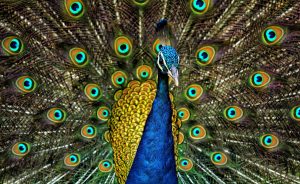
Photo By Jatin Sindhu – Own work
Am I the only one to have spent my childhood totally captivated by the beauty of the peacock? At the age of 7 or 8, I had no knowledge of the Greek myth that a peacock’s plumage was the product of Hera placing the 100 eyes of her faithful Argus on its hitherto plain-Jane tail (!) or that courageous Vikings were reputedly buried with a peacock tail feather or that “die goldene pave” or “the golden peacock” was a symbol which elicited many Yiddish songs and poems. I just knew that the peacock was the most glorious, glamorous bird I had ever seen; a creature from another dimension.
My grandmother used to fuss when I brought bedraggled feathers home from a visit to Golders Hill Park, lamenting the fact they were “dirty” (what’s a little mud!) and “covered in fleas” (I was sure then that a little soap and water would kill anything nasty). Watching those NW11 peacocks strut, with open mouth (mine, that is), was the highlight of my trip, although as they were kept without a roof, I sometimes had to satisfy myself instead with listening to them calling loudly to each other from the nearby woods. Even in their absence, my sisters and I would jostle for position at the railings, having scoured the surrounding land first for the perfect shaped stick to trap any fallen plumes and drag them back towards the wire mesh where our nimble fingers could prise them through the bars.
We didn’t only admire peacocks down South on our visits to my grandparents; fortunately they had them up North too; at Fountains Abbey, at Castle Howard, at Harewood House. But those peacocks roamed freely and were more difficult to pin down, so it’s the Golders Green peacocks I remember the most; the haughty walk, the jaunty, bobbing head-dress, the shimmering blue neck, the swish and whoosh of their multi-coloured tail display and those eyes, those fabulous, mesmerising, glistening eyes.
I had no idea then of the competing scientific theories for the evolutionary origin of that fantastic display; that Charles Darwin developed a ‘sexual selection’ theory specially for peacocks, which was widely discredited at the time (poor man), that the painter Thayer seriously tried to maintain it was camouflage (perhaps when viewed against a background of… peacock feathers), and that Zahavi, in the 1970s, opined that it was a form of ‘honest signalling’ to a prospective mate. My favourite of all these theories, however, has to be Ronald Fisher’s ‘sexy son’ hypothesis (c1930 – great name), which provides that a female chooses a male who possesses genes which will produce the best chance of future reproductive success for their male offspring; that is, an attractive (and promiscuous) male partner is likely to lead to your own sons being successful ‘in the lady department’ too, producing lots of grandsons and creating lots of copies of your genes for many generations to come.
But however fascinating these theories may be (especially when extrapolated to the human population), peacocks will forever remain for me a symbol of everything fabulous and mystical in our lives.
Note: this post was inspired by a recent article about a woman who tried to take a peacock on an internal US flight, having booked it a seat, to help ease her anxiety.
